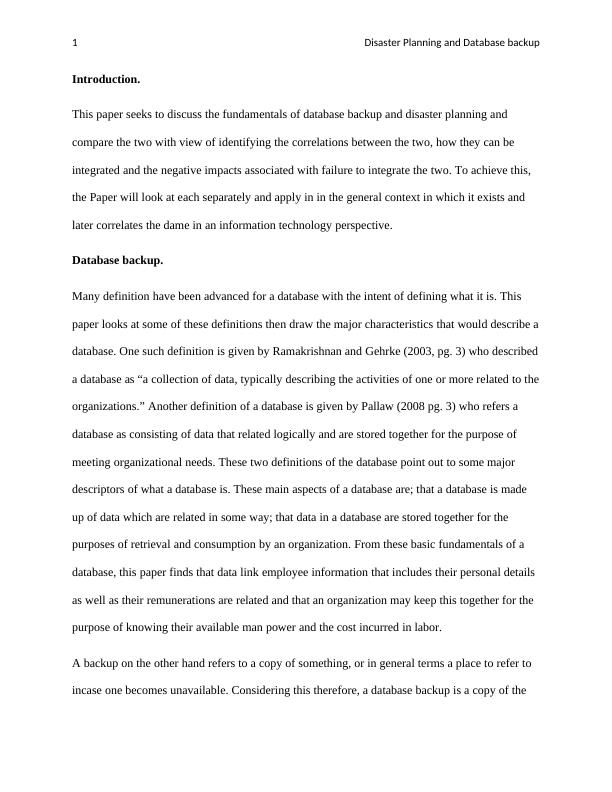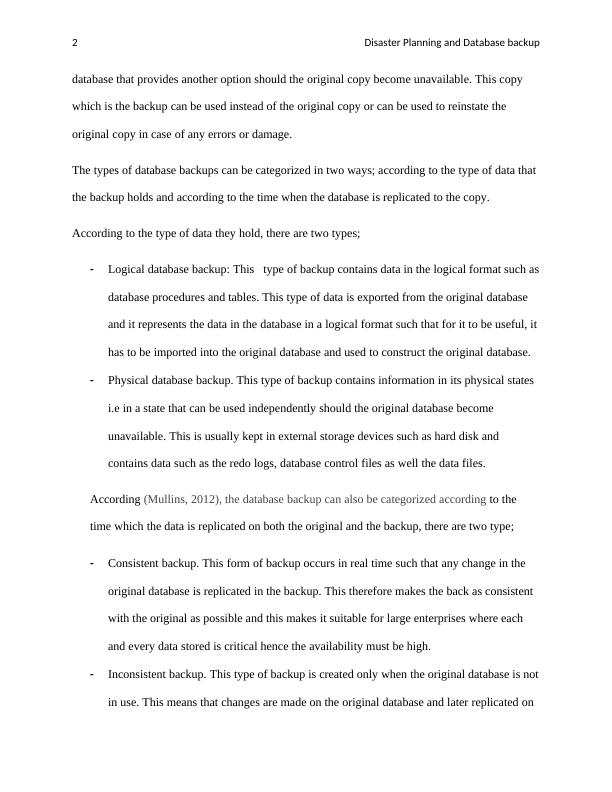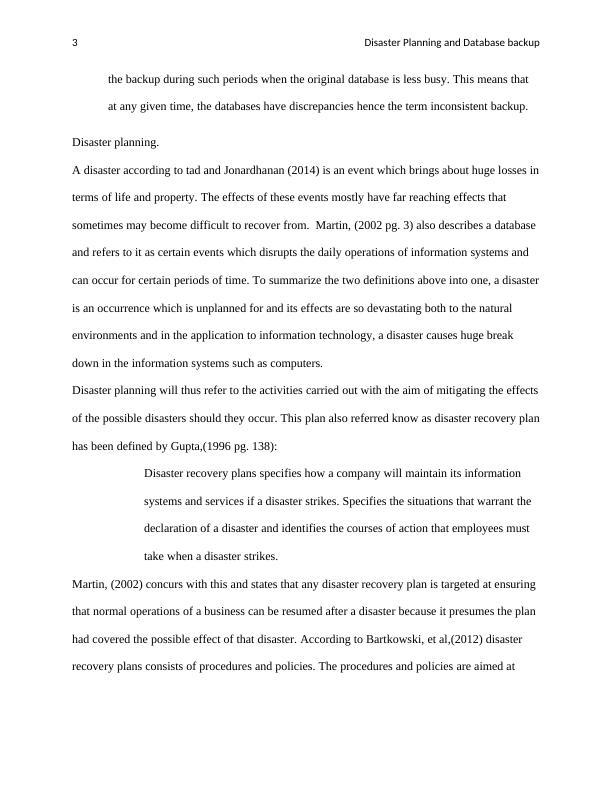Ask a question from expert
Disaster Planning and Database Backup: Assignment
6 Pages1804 Words153 Views
Added on 2021-10-01
Disaster Planning and Database Backup: Assignment
Added on 2021-10-01
BookmarkShareRelated Documents
1Disaster Planning and Database backup
Introduction.
This paper seeks to discuss the fundamentals of database backup and disaster planning and
compare the two with view of identifying the correlations between the two, how they can be
integrated and the negative impacts associated with failure to integrate the two. To achieve this,
the Paper will look at each separately and apply in in the general context in which it exists and
later correlates the dame in an information technology perspective.
Database backup.
Many definition have been advanced for a database with the intent of defining what it is. This
paper looks at some of these definitions then draw the major characteristics that would describe a
database. One such definition is given by Ramakrishnan and Gehrke (2003, pg. 3) who described
a database as “a collection of data, typically describing the activities of one or more related to the
organizations.” Another definition of a database is given by Pallaw (2008 pg. 3) who refers a
database as consisting of data that related logically and are stored together for the purpose of
meeting organizational needs. These two definitions of the database point out to some major
descriptors of what a database is. These main aspects of a database are; that a database is made
up of data which are related in some way; that data in a database are stored together for the
purposes of retrieval and consumption by an organization. From these basic fundamentals of a
database, this paper finds that data link employee information that includes their personal details
as well as their remunerations are related and that an organization may keep this together for the
purpose of knowing their available man power and the cost incurred in labor.
A backup on the other hand refers to a copy of something, or in general terms a place to refer to
incase one becomes unavailable. Considering this therefore, a database backup is a copy of the
Introduction.
This paper seeks to discuss the fundamentals of database backup and disaster planning and
compare the two with view of identifying the correlations between the two, how they can be
integrated and the negative impacts associated with failure to integrate the two. To achieve this,
the Paper will look at each separately and apply in in the general context in which it exists and
later correlates the dame in an information technology perspective.
Database backup.
Many definition have been advanced for a database with the intent of defining what it is. This
paper looks at some of these definitions then draw the major characteristics that would describe a
database. One such definition is given by Ramakrishnan and Gehrke (2003, pg. 3) who described
a database as “a collection of data, typically describing the activities of one or more related to the
organizations.” Another definition of a database is given by Pallaw (2008 pg. 3) who refers a
database as consisting of data that related logically and are stored together for the purpose of
meeting organizational needs. These two definitions of the database point out to some major
descriptors of what a database is. These main aspects of a database are; that a database is made
up of data which are related in some way; that data in a database are stored together for the
purposes of retrieval and consumption by an organization. From these basic fundamentals of a
database, this paper finds that data link employee information that includes their personal details
as well as their remunerations are related and that an organization may keep this together for the
purpose of knowing their available man power and the cost incurred in labor.
A backup on the other hand refers to a copy of something, or in general terms a place to refer to
incase one becomes unavailable. Considering this therefore, a database backup is a copy of the

2Disaster Planning and Database backup
database that provides another option should the original copy become unavailable. This copy
which is the backup can be used instead of the original copy or can be used to reinstate the
original copy in case of any errors or damage.
The types of database backups can be categorized in two ways; according to the type of data that
the backup holds and according to the time when the database is replicated to the copy.
According to the type of data they hold, there are two types;
-Logical database backup: This type of backup contains data in the logical format such as
database procedures and tables. This type of data is exported from the original database
and it represents the data in the database in a logical format such that for it to be useful, it
has to be imported into the original database and used to construct the original database.
-Physical database backup. This type of backup contains information in its physical states
i.e in a state that can be used independently should the original database become
unavailable. This is usually kept in external storage devices such as hard disk and
contains data such as the redo logs, database control files as well the data files.
According (Mullins, 2012), the database backup can also be categorized according to the
time which the data is replicated on both the original and the backup, there are two type;
-Consistent backup. This form of backup occurs in real time such that any change in the
original database is replicated in the backup. This therefore makes the back as consistent
with the original as possible and this makes it suitable for large enterprises where each
and every data stored is critical hence the availability must be high.
-Inconsistent backup. This type of backup is created only when the original database is not
in use. This means that changes are made on the original database and later replicated on
database that provides another option should the original copy become unavailable. This copy
which is the backup can be used instead of the original copy or can be used to reinstate the
original copy in case of any errors or damage.
The types of database backups can be categorized in two ways; according to the type of data that
the backup holds and according to the time when the database is replicated to the copy.
According to the type of data they hold, there are two types;
-Logical database backup: This type of backup contains data in the logical format such as
database procedures and tables. This type of data is exported from the original database
and it represents the data in the database in a logical format such that for it to be useful, it
has to be imported into the original database and used to construct the original database.
-Physical database backup. This type of backup contains information in its physical states
i.e in a state that can be used independently should the original database become
unavailable. This is usually kept in external storage devices such as hard disk and
contains data such as the redo logs, database control files as well the data files.
According (Mullins, 2012), the database backup can also be categorized according to the
time which the data is replicated on both the original and the backup, there are two type;
-Consistent backup. This form of backup occurs in real time such that any change in the
original database is replicated in the backup. This therefore makes the back as consistent
with the original as possible and this makes it suitable for large enterprises where each
and every data stored is critical hence the availability must be high.
-Inconsistent backup. This type of backup is created only when the original database is not
in use. This means that changes are made on the original database and later replicated on

3Disaster Planning and Database backup
the backup during such periods when the original database is less busy. This means that
at any given time, the databases have discrepancies hence the term inconsistent backup.
Disaster planning.
A disaster according to tad and Jonardhanan (2014) is an event which brings about huge losses in
terms of life and property. The effects of these events mostly have far reaching effects that
sometimes may become difficult to recover from. Martin, (2002 pg. 3) also describes a database
and refers to it as certain events which disrupts the daily operations of information systems and
can occur for certain periods of time. To summarize the two definitions above into one, a disaster
is an occurrence which is unplanned for and its effects are so devastating both to the natural
environments and in the application to information technology, a disaster causes huge break
down in the information systems such as computers.
Disaster planning will thus refer to the activities carried out with the aim of mitigating the effects
of the possible disasters should they occur. This plan also referred know as disaster recovery plan
has been defined by Gupta,(1996 pg. 138):
Disaster recovery plans specifies how a company will maintain its information
systems and services if a disaster strikes. Specifies the situations that warrant the
declaration of a disaster and identifies the courses of action that employees must
take when a disaster strikes.
Martin, (2002) concurs with this and states that any disaster recovery plan is targeted at ensuring
that normal operations of a business can be resumed after a disaster because it presumes the plan
had covered the possible effect of that disaster. According to Bartkowski, et al,(2012) disaster
recovery plans consists of procedures and policies. The procedures and policies are aimed at
the backup during such periods when the original database is less busy. This means that
at any given time, the databases have discrepancies hence the term inconsistent backup.
Disaster planning.
A disaster according to tad and Jonardhanan (2014) is an event which brings about huge losses in
terms of life and property. The effects of these events mostly have far reaching effects that
sometimes may become difficult to recover from. Martin, (2002 pg. 3) also describes a database
and refers to it as certain events which disrupts the daily operations of information systems and
can occur for certain periods of time. To summarize the two definitions above into one, a disaster
is an occurrence which is unplanned for and its effects are so devastating both to the natural
environments and in the application to information technology, a disaster causes huge break
down in the information systems such as computers.
Disaster planning will thus refer to the activities carried out with the aim of mitigating the effects
of the possible disasters should they occur. This plan also referred know as disaster recovery plan
has been defined by Gupta,(1996 pg. 138):
Disaster recovery plans specifies how a company will maintain its information
systems and services if a disaster strikes. Specifies the situations that warrant the
declaration of a disaster and identifies the courses of action that employees must
take when a disaster strikes.
Martin, (2002) concurs with this and states that any disaster recovery plan is targeted at ensuring
that normal operations of a business can be resumed after a disaster because it presumes the plan
had covered the possible effect of that disaster. According to Bartkowski, et al,(2012) disaster
recovery plans consists of procedures and policies. The procedures and policies are aimed at

End of preview
Want to access all the pages? Upload your documents or become a member.
Related Documents
College Data System: Best Practices for Information Managementlg...
|9
|1631
|78
Database Model Designlg...
|10
|2343
|341
Systems Analysis and Design Assignmentlg...
|7
|1803
|190
Client Management System Database for Aisle Perfectlg...
|3
|931
|125
Basic Concepts of SAN and its Benefitslg...
|15
|3282
|77
Critique of Articlelg...
|6
|1368
|72